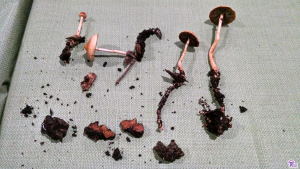#065: Trametes versicolor, The Turkey Tail
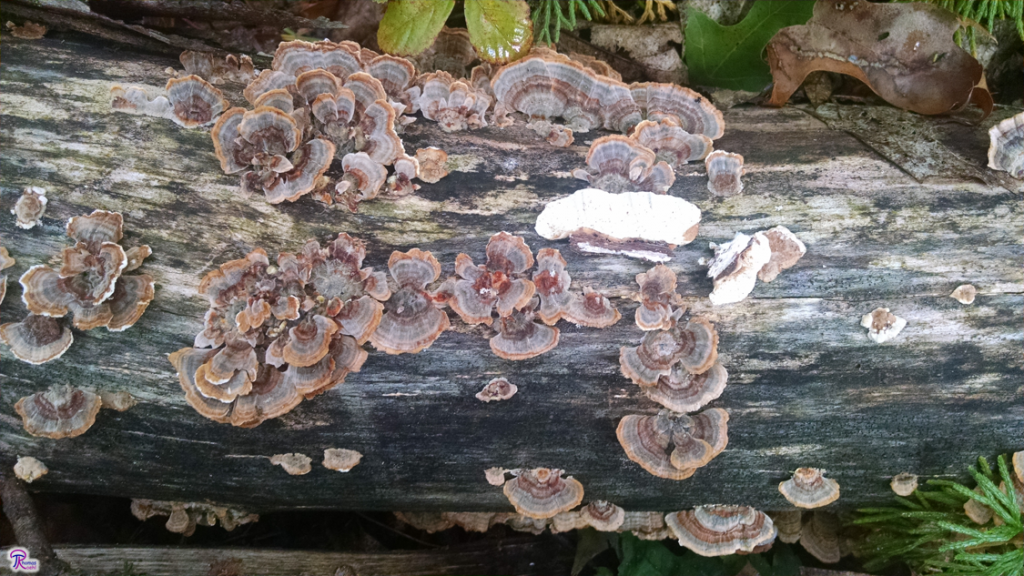
The Turkey Tail can display many colors on its pileus, from the more common browns, greys, and oranges to the rarer blues and greens. When actively growing, the edge of the pileus is the same color as the pore surface (usually white, as seen in the center-right mushroom that has been flipped over).
In honor of the recent Thanksgiving holiday, I chose to rework this post on the Turkey Tail. I will continue discussing mycotoxins next week.
It is easy to see why Trametes versicolor is commonly called the “Turkey Tail”: the upper surface of the fan-shaped polypore sports rings of color that vary from gray to brown to reddish-orange. In fresh specimens, the edge of the mushroom is white, making it look remarkably like the displayed tail of a wild turkey. T. versicolor is a very common decomposer and produces mushrooms that are visible all year, so you can probably find it the next time you walk through the woods.1,2
Description
Trametes versicolor is a very common find on dead logs in North America. The mushrooms are thin and usually have a radius of no more than 5cm. The individual mushrooms are fan-shaped to kidney-shaped to circular, depending where on the log the mushroom is found. Turkey Tail mushrooms grow out from a central point, but attach directly to their substrate wherever there is contact. This growth pattern produces fan-shaped to shelf-shaped “brackets” on the side of a log or circular rosettes on the top of a log. T. versicolor loves to make mushrooms; it is common to find hundreds of Turkey Tail mushrooms covering a single log, making them very easy to see in the forest. In these close quarters, individual fruiting bodies often fuse together to make very long brackets.1,3–5
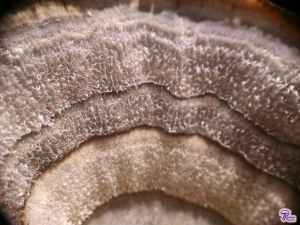
Trametes versicolor is known for its pileus, which contains contrasting bands of colors and textures.
Of course, the most striking feature of T. versicolor is its pileus, which is characterized by concentric rings of color. The colors displayed by Turkey Tail mushrooms vary widely from individual to individual. The most common colors are varying shades of gray, brown, and orange, but one frequently finds mushrooms exhibiting red, blue, and/or green. Along the edge, T. versicolor usually has a pale band that is the same color as the surface underneath. I find this outer band often disappears after the mushroom stops growing. It is interesting to note that all the mushrooms produced by a single individual will have the same banding pattern, making these rings a fungal fingerprint of sorts.1,3,4
Not only do these concentric zones vary in color, but they also vary in texture. Each ring has a specific texture, which can be smooth to velvety to fuzzy. You often find that fuzzier rings alternate with smoother ones. Furthermore, the zonate rings differ in relative elevation. Some rings will be higher than their neighbors, while others will be lower. Fresh specimens of the Turkey Tail can be spectacularly beautiful, especially when the fungus is producing mushrooms en masse.1,3,4
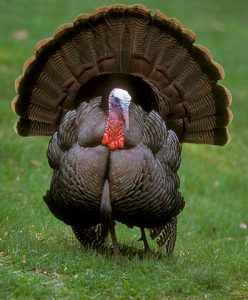
The common name “Turkey Tail” derives from the tail of a wild turkey, which has similar bands of color.
The underside of the mushroom is pure white to yellowish, which provides a nice contrast to the colorful upper surface. If you look closely, you will be able to see that the underside is covered with many, tiny pores (3-8 pores per millimeter). The pores become yellower and more angular as they age. This surface produces whitish spores, although checking the spore print is not very helpful in differentiating between similar polypores.1,3,4
The flesh is thin (the mushrooms are usually no more than 2mm thick), whitish, and leathery, so fresh Turkey Tails will bend quite a bit without breaking. Because of their leathery texture, you can usually find old mushrooms long after they stop growing. However, these older fruiting bodies are less colorful and often become green with algae.1,3,4
Ecology
T. versicolor is saprobic on the dead wood of hardwoods and occasionally on conifers. It selectively decomposes the lignin and leaves the cellulose, thereby causing a white rot. This mushroom fruits whenever it can, which is usually spring through fall. Because the Turkey Tail is so tough, fruiting bodies last for a very long time and you can find the mushroom at any time of the year. T. versicolor is very common and grows in forests all over the world.1–5

The Turkey Tail often fruits abundantly. In this picture, it has completely covered the log (which was 3-4ft in diameter).
Similar Species
The most problematic species are close relatives of T. versicolor. There are a few species of Trametes that exhibit fuzzy zonate caps, have leathery flesh, grow in brackets on dead logs, and are roughly the same size as T. versicolor. T. hirsuta is nearly indistinguishable from T. versicolor. I’m not confident that I could differentiate the two in the field, but T. hirsuta tends to have fewer colors (it sticks to browns and grays), a more consistently hairy cap, and a brownish margin.1 In fact, I may have misidentified the small pictures in this post, but they seem a bit more like the true Turkey Tail to me. T. villosa is easier to distinguish; it only has gray and beige tones and features larger ragged pores.6 There are also a number of other Trametes species that feature zonate caps and pores, but these lack at least one of the following features: rings of strongly contrasting colors, a fuzzy cap surface, or tiny pores.1
Apart from the other Trametes species, the Turkey Tail is a distinctive mushroom. However, the amateur mushroom hunter may get confused by some other very common mushrooms. Both Stereum ostrea (the False Turkey Tail FFF#144) and Lenzites betulina (the Gilled Polypore, FFF#168) grow as bracket fungi on wood and produce colorful, zonate mushrooms. However, a quick look at the underside of their mushrooms will show that neither one has pores: S. ostrea is completely smooth and L. betulina has gills.4,5 Trichaptum biforme (the Violet Toothed Polypore) is also zonate, but not quite so colorful. Its margin is usually purplish and if you flip it over you will see a purplish, toothed surface (these teeth are actually eroded pores).7 A few other polypores with irregular pores have zonate caps and may be confused with the Turkey Tail at first glance. The contrasting colors, hairy cap, and small pores are once again useful for distinguishing these from the true Turkey Tail.1
Edibility and Uses
The Turkey Tail is usually considered inedible due to its leathery texture, but it is sometimes made into a tea or tincture. T. versicolor tea has long been used for its medicinal properties. The mushroom’s suspected medicinal benefits have received a fair amount of attention from researchers. A few compounds have been identified in T. versicolor which have anti-tumor properties. The most significant of these is polysaccharide K (shortened to PSK), which is sold commercially as Krestin.5,8,9 However, there haven’t been any robust scientific studies to back up the usefulness of T. versicolor tea.1
T. versicolor has also been investigated for its bioremediation potential and for its potential use in biopulping. The Turkey Tail is a white rotter that doesn’t touch cellulose, which is the primary ingredient in paper. This makes the fungus potentially useful in the papermaking process.2
Taxonomy
The Turkey Tail has been shuffled between a few different genera over the years, so older field guides sometimes use other names for the species. Polyporus versicolor and Coriolus versicolor are the two most common alternate names.2,5 Unsurprisingly, T. versicolor belongs to the family Polyporaceae, which contains the core group of polypores.2
| Kingdom | Fungi |
| Division (Phylum) | Basidiomycota |
| Subdivision (Subphylum) | Agaricomycotina |
| Class | Agaricomycetes |
| Order | Polyporales |
| Family | Polyporaceae |
| Genus | Trametes |
| Species | Trametes hirsuta (L.) Lloyd10 |
This post does not contain enough information to positively identify any mushroom. When collecting for the table, always use a local field guide to identify your mushrooms down to species. If you need a quality, free field guide to North American mushrooms, I recommend Michael Kuo’s MushroomExpert.com. Remember: when in doubt, throw it out!
See Further:
http://www.mushroomexpert.com/trametes_versicolor.html
http://botit.botany.wisc.edu/toms_fungi/aug97.html
http://www.messiah.edu/Oakes/fungi_on_wood/poroid%20fungi/species%20pages/Trametes%20versicolor.htm
http://www.mykoweb.com/CAF/species/Trametes_versicolor.html
http://www.midwestmycology.org/Mushrooms/Species%20listed/Trametes%20versicolor%20species.html
Citations
- Kuo, M. Trametes versicolor. MushroomExpert.Com (2017). Available at: http://www.mushroomexpert.com/trametes_versicolor.html. (Accessed: 24th November 2017)
- Volk, T. J. Tom Volk’s Fungus of the Month for August 1997. Tom Volk’s Fungi (1997). Available at: http://botit.botany.wisc.edu/toms_fungi/aug97.html. (Accessed: 24th November 2017)
- Emberger, G. Trametes versicolor. Fungi Growing on Wood (2008). Available at: http://www.messiah.edu/Oakes/fungi_on_wood/poroid%20fungi/species%20pages/Trametes%20versicolor.htm. (Accessed: 24th November 2017)
- Wood, M. & Stevens, F. California Fungi—Trametes versicolor. The Fungi of California Available at: http://www.mykoweb.com/CAF/species/Trametes_versicolor.html. (Accessed: 24th November 2017)
- Trametes versicolor (aka Coriolus versicolor, Polyporus versicolor). Midwest American Mycological Information Available at: http://www.midwestmycology.org/Mushrooms/Species%20listed/Trametes%20versicolor%20species.html. (Accessed: 24th November 2017)
- Kuo, M. Trametes villosa. MushroomExpert.Com (2005). Available at: http://www.mushroomexpert.com/trametes_villosa.html. (Accessed: 24th November 2017)
- Kuo, M. Trichaptum biforme. MushroomExpert.Com (2004). Available at: http://www.mushroomexpert.com/trichaptum_biforme.html. (Accessed: 24th November 2017)
- Amy. Trametes Versicolor: The Colorful Turkey Tail Mushroom. Mushroom Appreciation Available at: http://www.mushroom-appreciation.com/trametes-versicolor.html. (Accessed: 24th November 2017)
- Turkey Tail Plugs – (Trametes versicolor). Mushroom Mountain Available at: https://mushroommountain.com/products/turkeyplugs. (Accessed: 24th November 2017)
- Trametes versicolor. Mycobank Available at: http://www.mycobank.org/Biolomics.aspx?Table=Mycobank&Rec=65392&Fields=All. (Accessed: 24th November 2017)

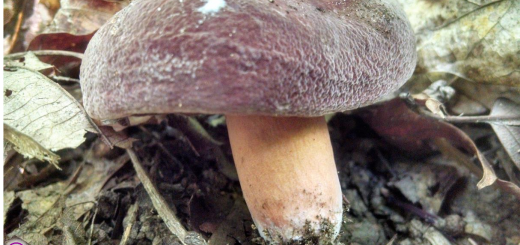

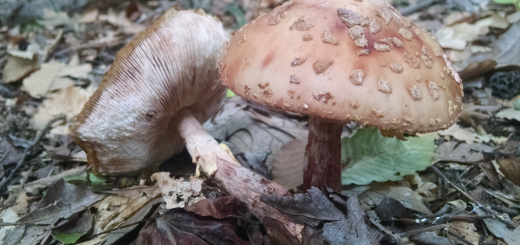





![#011: Characteristics of Kingdom Fungi [Archived]](https://www.fungusfactfriday.com/wp-content/themes/hueman/assets/front/img/thumb-small-empty.png)

